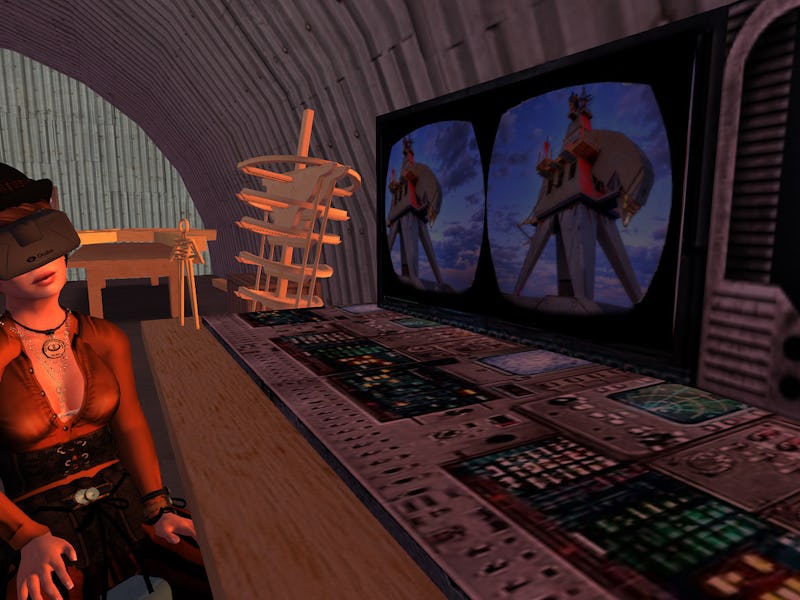How Much Would it Cost to Fully Immerse Your Five Senses In VR?
A little short of a million, but the math's fun!

When the Oculus Rift arrives, sometime in early 2016, it will cost early adopters something on the order of $1,500 for the headset and computer to run it. It will offer access to immersive environments, but without complete immersion. Sure, the Rift will get your eyes and ears into virtual reality, but what would cost to incept all your senses to convince into VR? Well, a lot. But can you really put a price on access to the metaverse?
Let’s break down the costs one sense at a time. Sight, it turns out, is the easy bit.
Sight
The Rift is aiming for your eyes with a whole lotta pixels, as engineer Atman Binstock describes in an Oculus blogpost: “the Rift runs at 2160×1200 at 90Hz split over dual displays, consuming 233 million pixels per second. At the default eye-target scale, the Rift’s rendering requirements go much higher: around 400 million shaded pixels per second.” Is that close enough for virtual photorealism? Oculus argues that photorealism isn’t needed to trick your brain into a sense of presence.
Cost: $1,500
Hearing
In early November, audio tech titan Sennheiser unveiled an update to its highest end headphones, Orpheus. The company says these headphones boast 0.01 percent harmonic distortion and frequency ranges from 8 Hz to over 100 kHz — which is great news if you are actually also a porpoise, as human hearing fizzles out at about the 20 kHz range.
Cost: $55,000
Smell
A device called FeelReal is a mask that you wear over your face while you’re in a virtual reality. It can mist on you and blow hot air, and also offers scent. Currently, the “odor generator” is limited to seven smells (including “jungle” and “fire” but not, surprisingly, vanilla) and went for a minimum of $250 on an unsuccessful Kickstarter. The Feelreal might have some kinks to work out — it’s been compared to a torture device — and could consider expanding its scent repertoire. In a study that found humans detect 1 trillion unique smells, neurobiologists used 128 odor molecules. Increase the FeelReal’s price by a factor of 18 (128 divided by seven), and maybe it would be less tortuous and more aromatic.
Cost: $4,500
Taste
Food, and the digestive sensations associated with it, is a tough simulated cookie. 3D food printers exist, which you can buy for about $5,000 to $10,000. But most of what they spit up are either gastronomic experiment or variations on theme of gel-concoction. Natural Machine’s Foodini prototype touts pizzas and pumpkin gnocchis, but it’s not totally automated. Frankly, for a more realistic experience, your simulated food-purchasing actions in the metaverse would have to trigger some sort of signal to a chef, or at least to an intern who will run into the room and pop a Mountain Dew in your hand once you’ve used a simulated vending machine. The average annual salary for a chef is $75,000; the average American spent $6,600 on food in 2013.
Cost: $81,600
Touch
Prototype designs like the Tesla Suit combine mo-cap with haptics. The Tesla Suit claims it can mimic the feelings fan breezes and shotgun blasts, thanks to thousands of electrical stimulators embedded in the fabric. It is machine-washable, maybe in case you like your VR of the Lawnmower Man variety (Tesla Suit didn’t respond immediately for comment from Inverse). The company — no relation to Elon Musk’s — has also kept mum on a potential price point. Salto, a suit with 19 sensors, costs $700; assuming that the price per sensor is fixed, and you a high-end thousand-sensor suit might be on the order of five figures.
But it’s not as simple as all that because touch also transpires within environments. Fine-tuned environmental control over a room is doable — just head to your nearest university’s biology department — but not cheap. Environmental Growth Chambers offers chambers adjustable from -40 to 158 degrees Fahrenheit, with 10 percent to 95 percent humidity. The rooms max out at 2,500 square feet, so keep that in mind when you’re developing your CableRobot simulator. EGC doesn’t list prices on its website, but you can buy used environmental test chambers on eBay for about a quarter of a million. We’ll take ours new.
Estimated Cost: $540,000
Proprioception
Omnidirectional treadmills aim to solve the movement problem of VR.The ones you can buy, such as the Virtuix Omni, cost several hundred dollars and have strangely low friction coefficients. There are several more development, like the Infinadeck, which don’t require slippery shoes. Still a work in progress — the Infinadeck maxes out at 6 mph, and runs at 70 dB (if you have the Sennheiser Orpheus on you won’t hear the ambient noise).
To increase the sense of motion and acceleration, you could stick something like the Infinadeck on something like the Max Planck Institute’s CableRobot simulator. The system uses eight cables to accelerate a platform with up to 1.5 times that of gravity. It took two years and team of European cybernetics experts to create, so the proof-of-concept device would not come cheap. Nor would bolting a treadmill on top.
Cost: The Infinadeck plus CableRobot simulator doesn’t exist yet, but two years of work from a robotics professor, plus parts and labor, might set you back about $220,000.